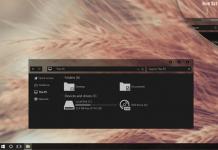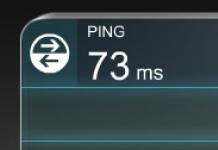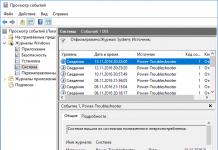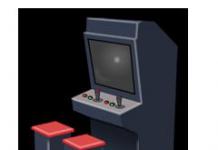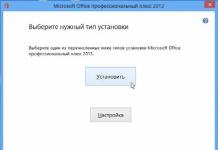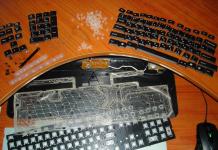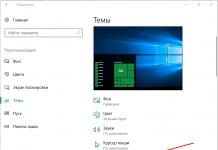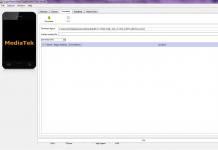Greetings, dear readers of the site. I want to tell you how to do it for windows xp professional system recovery using built-in tools rstrui.exe
And for Windows Vista and Windows 7
Step 1:
Restart your computer (if that doesn’t work, press and hold power button The system will turn off. Turn on the system), press the key F8 during boot until the selection menu appears (Step 2).
If you need to select an operating system, use the arrow keys to select the operating system you want for your computer and press ENTER.
Step 2:
Use the arrow keys to select safe mode with command line support
Step 3:
Log in as an administrator or with another account that has administrative rights.
Step 4:
At the command prompt, enter the command rstrui or c:\WINDOWS\system32\Restore\rstrui.exe and press ENTER.
Step 5:
To restore your computer, select Restoring your computer to an earlier state.
Step 6:
To restore the system, you must select test restore point . If the blocking occurred on February 21, 2012, then for a guaranteed recovery we select the previous recovery point 20, for example. When you click on it, information is displayed about what changes were made on that day. After selection presses Further
Step 7:
There is no need to do anything while the recovery is running; the operating system will reboot itself after the recovery.
Now your computer is in the same state as it was on the recovery checkpoint date.
Tested PERSONALLY on Windows XP Professional, The procedure is similar for operating systems W7 Windows 7 Windows Vista read
Recovery checkpoints ROCK!!! Never turn off Windows Recovery.This is such a lifesaver at the right time.
A little humor: How "Inexperienced users" of Microsoft Windows search in search engines- Windows,Windows,Windows orWindows
Rstrui exe is a utility responsible for restoring the Windows system. It is stored in the system32 folder and is irreplaceable if you need to “roll back” your computer. The free program Rstrui exe automatically monitors the changes that the user makes to the system every day and creates restore points itself. In the event of a failure, the Rstrui exe program offers a choice from which point you want to restore the computer to its previous state.
You may also need:
How to download Rstrui.exe for free?
It happens that when you try to restore the system using standard means, it produces errors. This can happen if the Rstrui exe program files are damaged or another program deleted them. In this case, you can download Rstrui exe for free. Rstrui exe allows you not only to select a restore point, but also its parameters, as well as undo the last computer restore. Often, malicious programs are disguised as this utility. You can download Rstrui exe for free and safely on our website
A product belonging to the Microsoft Windows Operating System, the rstrui.exe process is known as a System Restore Application, which is an EXE file that all PCs have. The rstrui.exe is a recovery center (System Restore Center) that aims to ease up scheduling of certain things like system restores or backups. This EXE file is used with a restore point that is created manually at any given time by the user, and the system can also automatically create restoration points. The stability and security of a user’s running computer is the responsibility of this EXE file and should thus be kept in check and be prevented from being terminated. Without the rstrui.exe file, a user’s PC could hardly operate properly. This EXE file should remain intact within its place and should not be transferred or removed. There are no known dangers coming from this EXE file that would present harm to the user’s computer system. The rstrui.exe process (System Restore) does not affect documents, e-mails, photos or any other personal files, so it is unlikely to help a user restore deleted files. This means files must be restored from a backup.
How can I stop rstrui.exe and should I?
Most non-system processes that are running can be stopped because they are not involved in running your operating system. rstrui.exe. is used by System Restore If you shut down rstrui.exe, it will likely start again at a later time either after you restart your computer or after an application start. To stop rstrui.exe, permanently you need to uninstall the application that runs this process which in this case is System Restore, from your system.
After uninstalling applications it is a good idea to scan you Windows registry for any left over traces of applications. Registry Reviver by ReviverSoft is a great tool for doing this.
Is this a virus or other security concern?
ReviverSoft Security Verdict
Please review rstrui.exe and send me a notification once it has
been reviewed.
What is a process and how do they affect my computer?
A process usually a part of an installed application such as System Restore, or your operating system that is responsible for running in functions of that application. Some application require that they have processes running all the time so they can do things such as check for updates or notify you when you get an instant message. Some poorly written applications have many processes that run that may not be required and take up valuable processing power within your computer.
Is rstrui.exe known to be bad for my computer's performance?
We have not received any complaint about this process having higher than normal impact on PC performance. If you have had bad experiences with it please let us know in a comment below and we will investigate it further.
Sometimes rstrui.exe and other EXE system errors can be related to problems in the Windows registry. Several programs can use the rstrui.exe file, but when those programs are uninstalled or modified, sometimes "orphaned" (incorrect) EXE registry entries are left behind.
Basically, this means that while the actual path of the file may have changed, its incorrect former location is still recorded in the Windows Registry. When Windows tries to look up these incorrect file references (file locations on your PC), rstrui.exe errors can occur. Additionally, a malware infection may have corrupted registry entries associated with Microsoft Windows Millenium Edition. Thus, these corrupt EXE registry entries need to be fixed to fix the problem at the root.
Manually editing the Windows registry to remove invalid rstrui.exe keys is not recommended unless you are PC service professional. Mistakes made when editing the registry can render your PC inoperable and cause irreparable damage to your operating system. In fact, even one comma placed in the wrong place can prevent your computer from booting!
Because of this risk, we highly recommend using a trusted registry cleaner such as %%product%% (Developed by Microsoft Gold Certified Partner) to scan and repair any rstrui.exe-related registry problems. Using a registry cleaner, you can automate the process of finding damaged registry entries, missing file references (such as the one causing the rstrui.exe error), and broken links within the registry. Before each scan, a backup copy is automatically created, allowing you to undo any changes with one click and protecting you from possible damage to your computer. The best part is that eliminating registry errors can dramatically improve system speed and performance.
Warning: Unless you are an experienced PC user, we DO NOT recommend manually editing the Windows Registry. Using Registry Editor incorrectly may cause serious problems that may require you to reinstall Windows. We do not guarantee that problems resulting from incorrect use of Registry Editor can be corrected. You use Registry Editor at your own risk.
Before you manually repair your Windows registry, you need to create a backup by exporting a portion of the registry associated with rstrui.exe (eg. Microsoft Windows Millenium Edition):
- Click on the button Begin.
- Enter " command" V search bar... DON'T CLICK YET ENTER!
- While holding down the keys CTRL-Shift on your keyboard, press ENTER.
- A dialog box for access will be displayed.
- Click Yes.
- The black box opens with a blinking cursor.
- Enter " regedit" and press ENTER.
- In the Registry Editor, select the rstrui.exe-related key (eg. Microsoft Windows Millenium Edition) you want to back up.
- On the menu File select Export.
- On the list Save to select the folder where you want to save the backup copy of the Microsoft Windows Millenium Edition key.
- In field File name Enter a name for the backup file, for example "Microsoft Windows Millenium Edition backup".
- Make sure the field Export range value selected Selected branch.
- Click Save.
- The file will be saved with extension .reg.
- You now have a backup of your rstrui.exe-related registry entry.
The following steps for manually editing the registry will not be described in this article, as they are likely to damage your system. If you would like more information about editing the registry manually, please check out the links below.
After removing viruses, the system may malfunction, access to the Internet or to certain sites may be lost, so after the antivirus has reported " All viruses are destroyed"The user is left alone with a faulty system. Let's look at options for restoring it.
:: Internet does not work
The cause of problems with the network can be either a consequence of a virus or the operation of crooked software. There are several options to solve this problem. Let's look at one here - AntiSMS utility.
Run with admin rights. The utility's operation is simple: a couple of mouse clicks and you're done.
:: Standard Windows system recovery
If system recovery has not been disabled in the system, then use this standard Windows functionality to solve problems. Also, this method of system recovery is effective if damage to the system was caused by the actions of inexperienced users or program errors.
Windows XP: Start -> All Programs -> Accessories -> System Tools -> System Restore. And select a restore point a few days before problems occur.
On Windows 7: Open System Restore by clicking the Start button. In the search box, type system restore, and then select System Restore from the list of results. Enter the administrator password or confirm password if prompted. Follow the wizard's instructions to select a restore point and restore your computer.If your computer won't boot, then try to go to Safe Mode Windows. To call it, press the key multiple times. F8(or F5) immediately after turning on the computer. In Safe Mode, also use the " Start" to restore the system, as written above.
If Safe Mode does not work, then try going into Safe Mode with Command Line Support. In this mode, there will no longer be a Start button, so you will need to call System Restore via the command line, to do this, type the line in the command line cd c:\windows\system32\restore and press the key Enter. Then type rstrui.exe and press Enter.
After this, the System Restore window should load. In this example, Windows is installed in the folder c:\windows, take this into account. If the Windows folder is not known, then use one command to call system restore:
%SystemRoot%\system32\restore\rstrui.exe
For Windows versionsVista/7/8 just enter the command rstrui.exe and press Enter.Attention, if you carry out this restoration after removing the virus, that is, it is possible to restore the virus, so in this case it is better to first try other methods of system recovery, which are discussed below (sfc, FixAfterVirus, AVZ, Windows Repair). Or restore to a date when the system was definitely not infected.
:: Restoring system files with the sfc command
If, after treatment, Windows malfunctions, then Start -> Run, enter the command sfc /scannow and press Enter- Windows will check the integrity of protected files on your computer. An OS installation disc may be required for recovery.
If you don't find the " Execute", then you can call it with the keyboard shortcut [ Win] + [R]. If the system does not boot into normal mode, then use Safe mode.
:: Recovery using Windows Repair (All In One)
Windows Repair (All In One) is a utility that will help fix errors in the system registry, restore original settings modified when the computer was infected or installed programs, restore stable operation of the Internet Explorer browser, the Windows Update service, the Windows Firewall and other services and OS components.
Execute Full fix, then restart your computer.
:: Antivirus utility AVZ
This utility has a lot of functionality; here we will analyze only those functions that can be used by an ordinary user to restore the system and correct errors after a virus.
Unzip the downloaded archive, then run the program. Necessarily update it: File -> Update databases.
Run " Troubleshooting Wizard" (on the menu " File").
Click " Start". If AVZ found any problems, then check the boxes for them and click " Fix flagged issues".
Then, from the File menu, select System Restore. Check all the boxes, EXCEPT these:
- Automatic correction of SPl/LSP settings;
- Reset SPI/LSP and TCP/IP settings (XP+);
- Complete re-creation of SPI settings;
- Replace the DNS of all connections with Google DNS
Then click " Perform marked operations", wait a bit, close the program and restart your computer.
Paragraph " Automatic correction of SPl/LSP settings" can be used if Internet access is lost after the virus (after application, restart the computer). Item " Resetting SPI/LSP and TCP/IP settings (XP+)" is also intended to restore access to the network, but this item can only be used if nothing else helps (after application, restart the computer). If both points above did not help restore the Internet, then there is another item " Complete re-creation of SPI settings" - apply only if the two points above did not help. Please note regarding these three points that we are talking about the fact that there is no access to the network at all.
:: Checking the hard drive (chkdsk)
This is a standard Windows program for checking the hard drive for errors. Open " My computer" (in Windows "7 simply " Computer") on Desktop or through the menu " Start". Select the desired partition or disk, right-click on it, click " Properties", select tab " Service" and press " Run check", check the boxes for " Automatically fix system errors" And " Scan and repair bad sectors". If you are checking the system partition, you will need to schedule the scan for the next startup (you will need to restart the computer to check).
Example launch via command line: chkdsk c: /f /r







